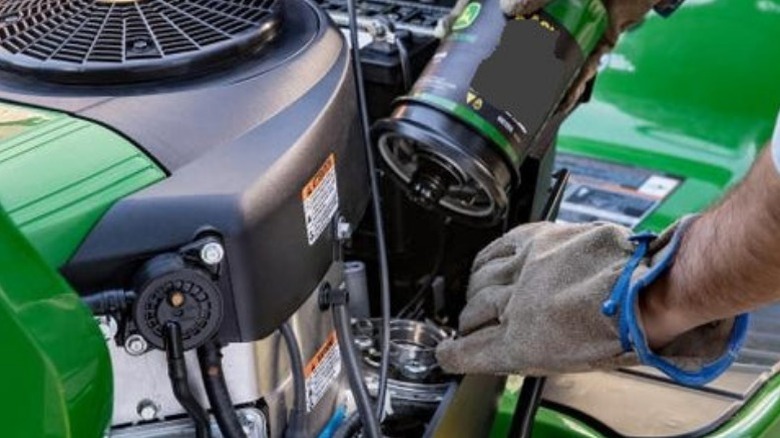Which Lawn Mowers Have Oil Filters? (And How Often To Change Them)
We may receive a commission on purchases made from links.
Seasonal lawn mower maintenance can be a hassle, but it's important to take care of it at the start of spring so that you can make sure your most vital lawn-care tool stays in top form. Changing or sharpening the blades, adding fresh gas, and cleaning out the air filter are all important tasks, but one of the most imperative steps in lawn mower maintenance is replacing the oil.
Those who've replaced the oil in vehicles and other large, engine-powered devices know that this often also means replacing the oil filter. These canister-like appendages keep the oil lubricating the moving parts in your engine cleaner for longer, and so you usually want to replace the filter just about any time you replace the oil in order to remove the dirt and debris that it's collected from the system. That said, not all machines that require oil also have a filter. Several small gas engines often skip this added feature and therefore don't require you to replace it when you replace the oil.
With that in mind, you might be surprised to learn that while many mowers do not require an oil filter, there are others that do. So it's important to consider which types need them and which don't if you want to be able to provide proper engine care. It's also worth knowing how often you should replace them.
Which types of lawn mowers have oil filters?
While there is some variation between different models, most standard push mowers do not have oil filters. The vast majority of these kinds of mowers simply rely on regular oil changes in order to remain clean and properly lubricated. Likewise, even the most powerful of electric lawn mowers don't require an oil filter since battery-powered engines don't require oil in order to operate.
Oil filters are commonly used on riding mowers, lawn tractors, and zero-turn mowers. You can also sometimes find them on commercial-grade push mowers, particularly those equipped with powerful engines that have displacements over 190ccs. Of course, you should always consult your owner's manual or look up your model's specifications online to be sure. This is a good idea anyway since you'll want to make sure you're using the right kind of oil for your mower. Failing that, you should examine the engine on the mower itself. There should be a small, cylindrical canister on the side or near the rear of the engine if it uses an oil filter. If one is not present (or a port where one should be), then your mower likely doesn't require an oil filter.
How often should you replace the oil filter on a lawn mower?
Those of you who do need one will be interested in learning how often they're supposed to replace it. You know how the classic rule of thumb for a car is every three months or every 3,000 miles, whichever comes first? Mowers have a similar rule, but it's a bit more lax: It's recommended that you change your oil once per mowing season or once for every 50 hours of run time. For most people, this adds up to roughly the same time frame. Professional landscapers and groundskeepers may need to be a bit more vigilant about how many hours they're spending in the hot seat, though. Sports fields, campuses, and golfing greens take a lot longer to mow than your typical front yard, so it's probably a smart move to keep a log of the mower's hours of operation if you think it might need mid-season maintenance.
It's also good to be in the habit of replacing the filter whenever you're replacing the oil in your mower. These filters trap dirt and carbon buildup — substances that can harm your engine if left unchecked. Old filters can either become clogged by the debris that they have trapped, or they can lose their ability to hold these contaminants and allow them to circulate through the engine. You don't want all that leftover nastiness floating around in your freshly changed oil, as these substances can cause damage and reduce the efficiency of your mower over time.


